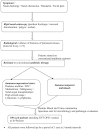Prevalence and clinical profile of fungal rhinosinusitis
- PMID: 27349695
- PMCID: PMC5010432
- DOI: 10.2500/ar.2016.7.0156
Prevalence and clinical profile of fungal rhinosinusitis
Abstract
Background: There are only a few landmark studies from the Indian subcontinent on fungal rhinosinusitis. The lack of awareness among clinicians regarding the varying clinical presentations of fungal rhinosinusitis prompted us to undertake this study.
Objective: To determine the prevalence, etiologic basis, clinical features, radiologic features, and microscopic features of fungal rhinosinusitis, and to evaluate the various treatment modalities available.
Methods: This was a prospective study in which evaluation of 100 patients with chronic rhinosinusitis was done. Specimens collected were subjected to both microbiology and pathologic examination; data collected, including clinical and radiologic features, were analyzed by the Pearson χ(2) test and Fisher's exact test.
Results: The prevalence of fungal rhinosinusitis in our study was 30% (n = 30). Mucor was the most commonly isolated species (n = 15 [50%]) of fungus. Pathologic examination had a higher sensitivity (76.67%) compared with microbiology tests (50%) in the diagnosis of fungal rhinosinusitis. Fungus ball (n = 14 [46.6%]) was the most prevalent entity in the spectrum of fungal rhinosinusitis. Forty percent of cases (n = 12) were of invasive fungal rhinosinusitis. The prevalence of fungal rhinosinusitis was higher among individuals who were immunocompetent (n = 17 [56.6%]). Of patients who were immunocompromised, 84.6% (n = 11) had mucormycosis.
Conclusions: Unilateral involvement of paranasal sinuses was more in favor of fungal etiology. Complications were more common in fungal rhinosinusitis caused by Mucor species. Mucormycosis, a rare clinical entity, in subjects who were immunocompetent, had a high prevalence in our study.
Conflict of interest statement
The authors have no conflicts of interest to declare pertaining to this article
Figures








References
-
- Milosev B, el-Mahgoub S, Aal OA, el-Hassan AM. Primary aspergilloma of the paranasal sinuses in Sudan. A review of seventeen cases. Br J Surg 56:132–137, 1969. - PubMed
-
- Stammberger H. Endoscopic surgery for mycotic and chronic recurring sinusitis. Ann Otol Rhinol Laryngol Suppl 119:1–11, 1985. - PubMed
-
- Hazarika P, Ravikumar V, Nayak RG, et al. Rhinocerebral mycosis. Ear Nose Throat J 63:464–468, 1984. - PubMed
-
- Chakrabarti A, Sharma SC, Chandler J. Epidemiology of pathogenesis of paranasal sinus mycoses. Otolaryngol Head Neck Surg 107:745–750, 1992. - PubMed
-
- Ferguson BJ. Fungus balls of the paranasal sinuses. Otolaryngol Clin North Am 33:389–398, 2000. - PubMed
LinkOut - more resources
Full Text Sources
Other Literature Sources

